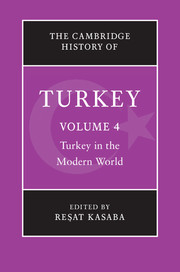Book contents
- Frontmatter
- 1 Introduction
- PART I OTTOMAN BACKGROUND AND TRANSITION
- PART II REPUBLIC OF TURKEY
- 7 Migration and Turkey: the dynamics of state, society and politics
- 8 The migration story of Turks in Germany: from the beginning to the end
- 9 Politics and political parties in Republican Turkey
- 10 Economic change in twentieth-century Turkey: is the glass more than half full?
- 11 Ideology, context and interest: the Turkish military
- 12 Kurds and the Turkish State
- 13 Islam and politics in contemporary Turkey
- 14 Sufism and Islamic groups in contemporary Turkey
- 15 Contestation and collaboration: women’s struggles for empowerment in Turkey
- 16 Art and architecture in modern Turkey: the Republican period
- 17 The novel in Turkish: narrative tradition to Nobel prize
- 18 A brief history of modern Istanbul
- Select bibliography
- Index
- References
9 - Politics and political parties in Republican Turkey
from PART II - REPUBLIC OF TURKEY
Published online by Cambridge University Press: 28 November 2009
- Frontmatter
- 1 Introduction
- PART I OTTOMAN BACKGROUND AND TRANSITION
- PART II REPUBLIC OF TURKEY
- 7 Migration and Turkey: the dynamics of state, society and politics
- 8 The migration story of Turks in Germany: from the beginning to the end
- 9 Politics and political parties in Republican Turkey
- 10 Economic change in twentieth-century Turkey: is the glass more than half full?
- 11 Ideology, context and interest: the Turkish military
- 12 Kurds and the Turkish State
- 13 Islam and politics in contemporary Turkey
- 14 Sufism and Islamic groups in contemporary Turkey
- 15 Contestation and collaboration: women’s struggles for empowerment in Turkey
- 16 Art and architecture in modern Turkey: the Republican period
- 17 The novel in Turkish: narrative tradition to Nobel prize
- 18 A brief history of modern Istanbul
- Select bibliography
- Index
- References
Summary
In the transition from a multinational empire to a nation-state, political life in the new Turkey experienced a radical transformation. There is still heated debate among scholars as to whether there was continuity or change in the Republic’s political life. Some have argued in favour of continuity, claiming that the architects of the Republic belonged to cadres who had acquired their experience of politics after 1908. That is true, though the transitions from empire to nation-state, from monarchy to republic, from theocracy to a laicist/secular state and society, seem sufficient reasons to strengthen the claims for change, even for revolutionary change.
When war ended in total collapse in November 1918, it seemed doubtful that a viable Turkish state would emerge from the ruins. The territory left to the Ottomans by the armistice of 1918, which the nationalists then claimed as the borders of the new Turkey, was also contested by Greece and Armenian nationalists, as well as by Britain and France. Thus before there could be any political life, the Turks had to salvage a new state from the ruins of empire, and that took almost five years of war and diplomacy to achieve. During these years the Turkish elites were divided. The sultan’s supporters relied on diplomacy and the goodwill of Britain for their very survival. But Britain had its own post-war agenda and did not support Istanbul’s aspirations. As a result, the sultan was left with a truncated state by virtue of the terms of the Treaty of Sèvres, which he was forced to sign on 10 August 1920.
- Type
- Chapter
- Information
- The Cambridge History of Turkey , pp. 226 - 265Publisher: Cambridge University PressPrint publication year: 2008
References
- 8
- Cited by

